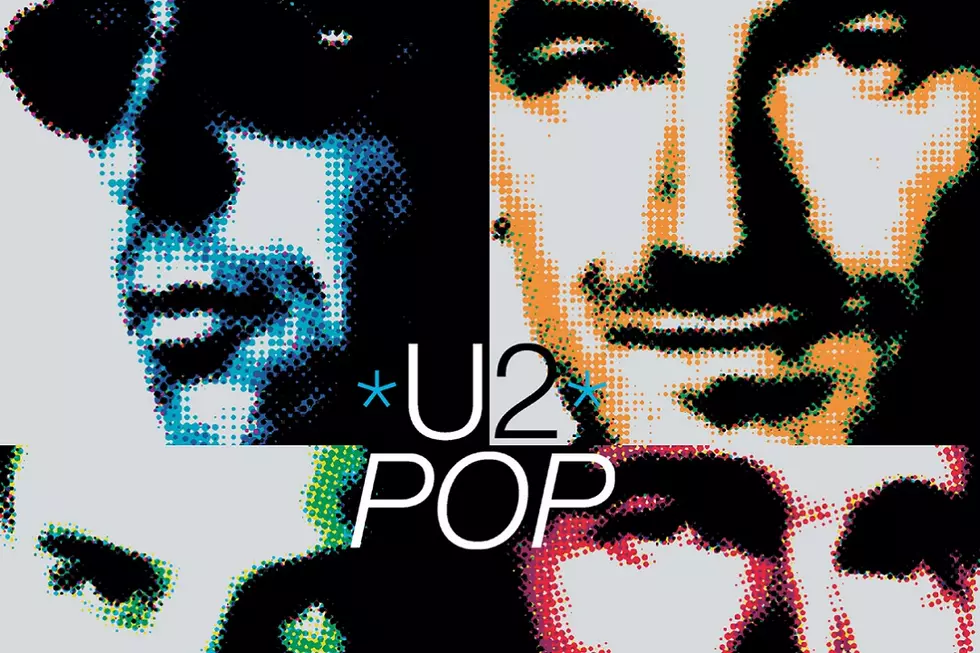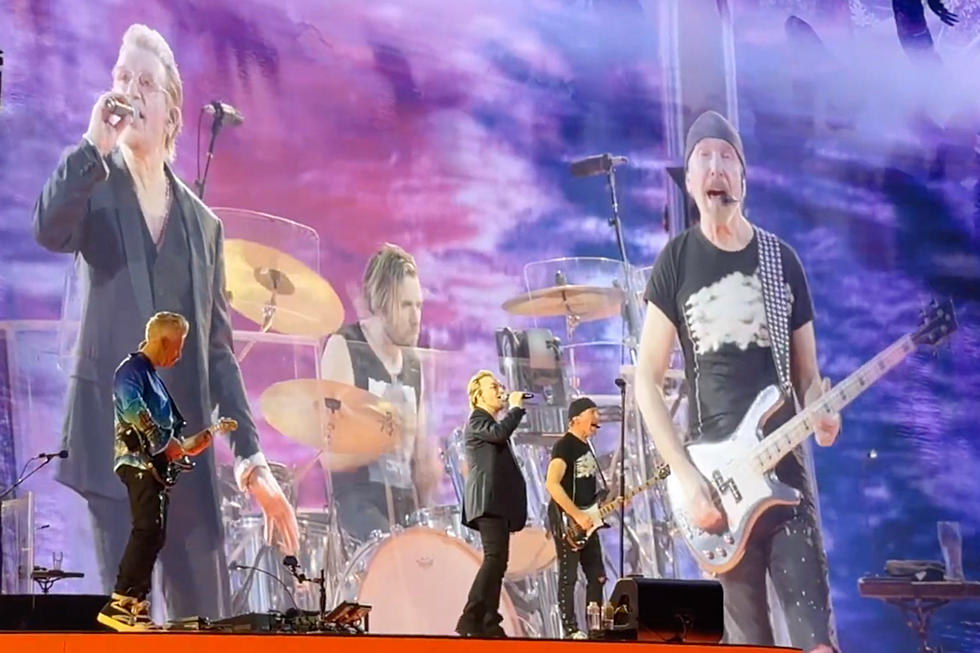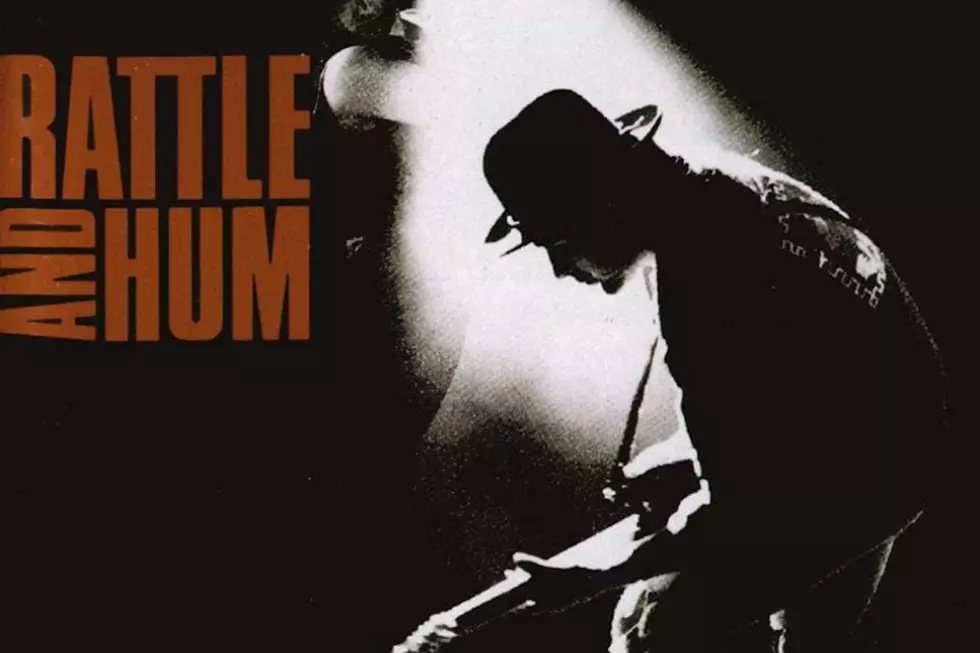
Why U2 Switched Gears Again With ‘Pop’
There’s so much baggage when it comes to U2’s Pop album that it’s difficult to know where to start unpacking. The band’s 1997 record, with its embrace of dance rhythms and sampling – and its accompanying tour, with its arch (literally), post-modern posturing – have become so reviled as missteps that it’s not simple to get to the heart of the music.
Well, first, context. By the time they were working on Pop, U2 had already reinvented themselves twice from their post-punk beginnings, first as earnest Americana interpreters in the ’80s then as ironic electro-rockers in the ’90s. As Bono once put it, “We had to shoot U2 in the head before anyone else did.”
For all the heat Pop takes, the album didn’t mark a huge stylistic change in the band. It was a continuation of U2’s ’90s explorations, which had included loops, dance-oriented rhythms and stylish, rocking viscosity since 1991’s Achtung Baby. The group had already embraced the samples and textures of electronica on 1993’s Zooropa and the 1995 Brian Eno-assisted side project Passengers.
So what was different about Pop? At the time of the album’s release, U2’s members emphasized the songwriting.
“We wanted it to be a record with some real songs, some discipline and some focus in the material,” the Edge told Reverberation, indicating that the Passengers album had gotten away from them a bit. “We also wanted to take in some new ideas from the world of dance music and hip-hop, or whatever, because we felt strongly that that's where music is at its most interesting at the moment.
"So, a lot of the time, it was really about finding our way into these worlds of trance and techno and hip-hop," the Edge added, "and learning how we could operate in those worlds, then integrating it back into the songs we’d started to write."
It was a long process, perhaps made longer by the amount of collaborators U2 worked with in 1995-96. Producers Flood, Howie B., Steve Osbourne and Nellee Hooper brought in samples, electronic music and funk grooves to inspire the band. The results became unwieldy as U2 played to samples, created sounds, then re-recorded new versions of the samples and finally tried to turn the recordings into coherent song ideas. It was a lot to bite off, as Bono admitted.
“We kind of knew what we wanted to do: write some great songs, but have it sound like something we’ve never done before, and we wanted to incorporate a lot of interesting music we’d been listening to,” Bono said in May 1997. “As we got into it, we discovered some of those ideas just were not gonna work, and we were heading down the road of creating an album that was hopelessly diverse.”
Listen to U2 Perform 'Mofo'
Not only hopelessly diverse, but behind schedule. The difficult sessions for Pop started to push U2 against a hard deadline. The group had agreed to begin its PopMart world tour in April 1997, with the idea that the album would be out by the holiday season of 1996. Instead, Pop didn’t even enter the mixing phase until November 1996, with the band frantically working to retool recordings. Bono allegedly came up with the melody for “Last Night on Earth” on the final day of recording.
The Edge later characterized Pop as a “compromise.” Band manager Paul McGuinness said it was the result of “too many cooks.” Regardless, it was a strange 60 minutes of music, front-loaded with blustery grooves and distorted beats, stopping for an interlude at “The Playboy Mansion” and ending with somber, even religious-themed material.
Still, upon its release on March 3, 1997, Pop became a big hit, debuting at No. 1 in many countries around the world and going gold in a matter of two weeks in the States. The record’s dance-afflicted lead single, “Discotheque,” hit No. 10 on the Billboard charts – becoming U2’s last Top 10 U.S. single to date.
But the initial rush of success – buoyed by career momentum and the hype of U2’s fast-approaching tour – faded fast. Initially positive reviews and reactions quickly turned more negative. People seemed to tire of the “ironic” U2 that would dress up as the Village People or incorporate a disco lemon into the stage design of a world tour.
Even though subsequent singles such as “Staring at the Sun” and “If God Will Send His Angels” had a more straight-forward sonic approach, U2 couldn’t manage to scrub away the dance-club glitter.
Listen to U2 Perform 'Staring at the Sun'
In the years since, the members of U2 have talked about their many frustrations with Pop. But their actions speak even louder about their dissatisfaction with the album and its material. For instance, U2 have remixed, re-arranged or re-recorded six of Pop’s 12 songs for releases on singles and compilations.
Their next album, 2000’s All That You Can’t Leave Behind, found U2 ditching irony and electronic accoutrements for a revisionist approach. Subsequent tours were almost completely devoid of Pop music, representing all U2 albums in the set list choices, with the exception of this one.
But as the backlash has grown, so has the anti-backlash, with writers and fans claiming that Pop was dismissed too easily and painted with too broad a disco-spangled brush. Critics have noted that, regardless of how late ’90s electronica has aged and how cloying “pop” irony had become, there are many seriously experimental (and just plain serious) songs on Pop.
Then there are some who lament the reaction to the band’s 1997 album because of how it changed U2. In the decades since Pop, the band has mostly steered clear of experimentation in favor of delivering music that sounds like the U2 of old. That was easier for many casual fans to swallow – leading to consensus Grammys, oldies-laden tours and a kinder, gentler rock ’n’ roll band – but it wasn't always exciting as the possibility for reinvention.
The Most Shocking Rock Star Fashion Reinventions
More From Ultimate Classic Rock









